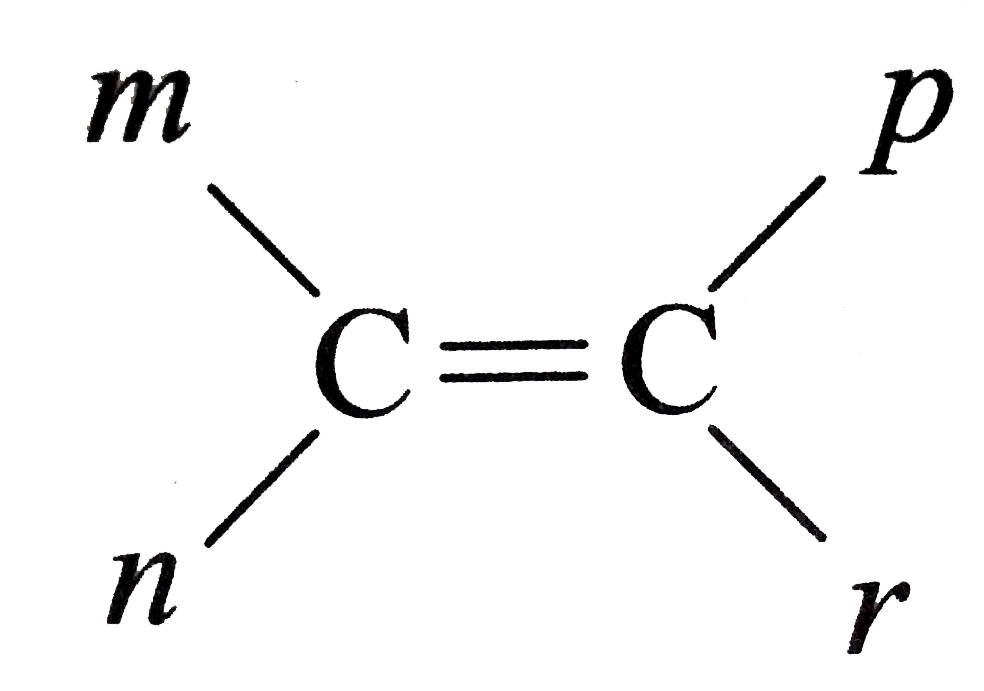Which of the following compounds will show geometrical isomerism ?
(a)
(d)
To determine which of the given compounds exhibit geometrical isomerism, we need to analyze each compound based on the conditions for geometrical isomerism. Geometrical isomerism occurs in alkenes when there are different groups attached to the carbon atoms involved in the double bond, and no two groups on the same carbon can be identical.
Let's analyze each compound step-by-step:
Step 1: Analyze Compound (a) H2C=CBr2
- Structure: H2C=C(Br)2
- On the first carbon (C1), there are two hydrogen atoms (H), and on the second carbon (C2), there are two bromine atoms (Br).
- Since both C1 and C2 have identical groups (two H's on C1 and two Br's on C2), this compound cannot show geometrical isomerism.
Step 2: Analyze Compound (b) (H3C)2C=CHCH3
- Structure: C(CH3)2=CH−CH3
- On the first carbon (C1), there are two methyl groups (CH3), and on the second carbon (C2), there is one hydrogen (H) and one methyl group (CH3).
- C1 has identical groups (two CH3), which means this compound cannot show geometrical isomerism.
Step 3: Analyze Compound (c) C6H5CH=CHCH3
- Structure: C6H5−CH=CH−CH3
- On the first carbon (C1) attached to the double bond, there is a phenyl group (C6H5) and a hydrogen (H). On the second carbon (C2), there is a hydrogen (H) and a methyl group (CH3).
- Since C1 has different groups (C6H5 and H) and C2 has different groups (H and CH3), this compound can show geometrical isomerism.
Step 4: Analyze Compound (d) CH3CH2(CH3)∣C=CHCH2CH3
- Structure: CH3−CH2−CH(CH3)=CH−CH2−CH3
- On the first carbon (C1) of the double bond, there is an ethyl group (CH2CH3) and a methyl group (CH3). On the second carbon (C2), there are two different groups: a hydrogen (H) and a CH2CH3 group.
- Since C1 has different groups (CH3 and CH2CH3) and C2 has different groups (H and CH2CH3), this compound can show geometrical isomerism.
Step 5: Analyze Compound (e) H3C−CH=C(Cl)(CH3)
- Structure: CH3−CH=CH(Cl)−CH3
- On the first carbon (C1) of the double bond, there is a methyl group (CH3) and a hydrogen (H). On the second carbon (C2), there is a chlorine (Cl) and a methyl group (CH3).
- Since C1 has different groups (H and CH3) and C2 has different groups (Cl and CH3), this compound can show geometrical isomerism.
Conclusion:
The compounds that show geometrical isomerism are:
- (c) C6H5CH=CHCH3
- (d) CH3CH2(CH3)∣C=CHCH2CH3
- (e) H3C−CH=C(Cl)(CH3)
Summary of Results:
- (a) No
- (b) No
- (c) Yes
- (d) Yes
- (e) Yes
- Structure: H2C=C(Br)2
- On the first carbon (C1), there are two hydrogen atoms (H), and on the second carbon (C2), there are two bromine atoms (Br).
- Since both C1 and C2 have identical groups (two H's on C1 and two Br's on C2), this compound cannot show geometrical isomerism.
- Structure: C(CH3)2=CH−CH3
- On the first carbon (C1), there are two methyl groups (CH3), and on the second carbon (C2), there is one hydrogen (H) and one methyl group (CH3).
- C1 has identical groups (two CH3), which means this compound cannot show geometrical isomerism.
- Structure: C6H5−CH=CH−CH3
- On the first carbon (C1) attached to the double bond, there is a phenyl group (C6H5) and a hydrogen (H). On the second carbon (C2), there is a hydrogen (H) and a methyl group (CH3).
- Since C1 has different groups (C6H5 and H) and C2 has different groups (H and CH3), this compound can show geometrical isomerism.
- Structure: CH3−CH2−CH(CH3)=CH−CH2−CH3
- On the first carbon (C1) of the double bond, there is an ethyl group (CH2CH3) and a methyl group (CH3). On the second carbon (C2), there are two different groups: a hydrogen (H) and a CH2CH3 group.
- Since C1 has different groups (CH3 and CH2CH3) and C2 has different groups (H and CH2CH3), this compound can show geometrical isomerism.
- Structure: CH3−CH=CH(Cl)−CH3
- On the first carbon (C1) of the double bond, there is a methyl group (CH3) and a hydrogen (H). On the second carbon (C2), there is a chlorine (Cl) and a methyl group (CH3).
- Since C1 has different groups (H and CH3) and C2 has different groups (Cl and CH3), this compound can show geometrical isomerism.
The compounds that show geometrical isomerism are:
- (c) C6H5CH=CHCH3
- (d) CH3CH2(CH3)∣C=CHCH2CH3
- (e) H3C−CH=C(Cl)(CH3)
- (a) No
- (b) No
- (c) Yes
- (d) Yes
- (e) Yes
Topper's Solved these Questions
- HYDROCARBONSBOOK - MODERN PUBLICATIONCHAPTER - HYDROCARBONSEXERCISE - PRACTICE PROBLEMS
34 Videos
- HYDROCARBONSBOOK - MODERN PUBLICATIONCHAPTER - HYDROCARBONSEXERCISE - Conceptual Questions
20 Videos
- HALOALKANES AND HALOARENESBOOK - MODERN PUBLICATIONCHAPTER - HALOALKANES AND HALOARENESEXERCISE - UNIT PRACTICE TEST
12 Videos
- HYDROGENBOOK - MODERN PUBLICATIONCHAPTER - HYDROGENEXERCISE - UNIT PRACTICE TEST (for Board Examination)
9 Videos
Similar Questions
Knowledge Check
The IUPAC name of CH3−C∣C2H5=CHCH3 is
A2-EthylbuteneB2-Ethylbut-2-eneC3-Methylpent-2-eneD3-Methylpent-3-eneH3C−O−CH2−Cl H3C−C∣∣O−CH2−Cl H3C−CH2−Cl H3C−Cl
AQ>P>S>RBP>Q>R>SCS>R>P>QDS>R>Q>PWhich amond the following are unsaturated hydrocarbons ?
(i) H3C−CH2−CH2−CH3
(ii) H3C−C≡C−CH3
(iii) H3C−CH∣ CH3−CH3
(iv) H3C−C∣CH3=CH2A(i) and (iii)B(ii) and (iii)C(ii) and (iv)D(iii) and (iv)
CH3−CH2−CH2−C∣OHH−CH3 and CH3−CH2−C∣OHH−CH2−CH2−CH3 are
View SolutionWrite the IUPAC names of the following structures :
(a)(a) (C2H5)4
(b) (CH3)2CHCH(CH3)2
(c) CH3CH2C∣CH3H(CH2)3C∣CH3H−C∣CH3H−CH2CH3
(d) (CH3)3,CCH2C(CH3)3CH3
View SolutionWrite the IUPAC name of CH3−C∣C2H5H−CH2−Cl.
View SolutionWhile of the following compounds will exhibit geometrical (or cis-trans) isomerism?
(i) CH3CH=CHCH2CH3
(ii) C6H5CH=CHCH3
(iii) CH2=C(CH3)2
(CH3)2C=CH−C2H5
Strategy: Essential requirement for any alkene to exhibit geometrical isomerism is that each of the double bonded carbon atoms should be attached to two different atoms or groups of atoms:

m≠nandp≠r. Notice that m and p may be same or different Similarly, nandr may be same or different.
View SolutionI.U.P.A.C name of H3C−H2C−HC=C∣CH3−HC∣CH3−CH2−CH2−CH3
View Solution
